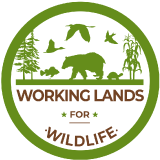-
 Building Your Own Conservation Team
Building Your Own Conservation Team
-
by
Gilbert Randolph
—
published
Jan 02, 2025
—
last modified
May 27, 2025 05:45 AM
—
filed under:
Working Lands for Wildlife,
Grasslands and Savannas,
Stories,
News,
Bobwhite,
Northern Bobwhite Quail
Building habitat on private land isn’t easy. That’s why Barb Heyen has built a “conservation team,” to help transform 120 acres of her property in southern Illinois from low quality pasture to quail and monarch-focused habitat.
Located in
Stories
-
 Restoring Upland Habitat in Arkansas' Grand Prairie
Restoring Upland Habitat in Arkansas' Grand Prairie
-
by
Gilbert Randolph
—
published
Jan 09, 2025
—
last modified
May 27, 2025 05:42 AM
—
filed under:
Working Lands for Wildlife,
Working Lands,
Grasslands and Savannas,
Stories
The Holmes farm, located in Prairie County Arkansas has been in the family for over 100 years and it sits in a quail focal area and right on the border of Arkansas’ Grand Prairie.
Located in
Stories
-
 Quail habitat also protects threatened orchid species in Tennessee
Quail habitat also protects threatened orchid species in Tennessee
-
by
Rachel Holt
—
published
May 26, 2025
—
last modified
May 27, 2025 01:39 PM
—
filed under:
WLFW,
Northern Bobwhite Quail,
Grasslands and Savannas,
Orchid,
Working Lands for Wildlife,
Tennessee,
Northern Bobwhite Quail, Grasslands & Savannas
Two rare species were recently found on working lands in Van Buren County
Located in
Stories
-
 How fall covey counts track the impact of habitat restoration
How fall covey counts track the impact of habitat restoration
-
by
Rachel Holt
—
published
May 27, 2025
—
filed under:
WLFW,
Working Lands for Wildlife,
Northern Bobwhite Quail,
Grasslands and Savannas,
Outcomes Assessments,
Audio Recording Unit
Surveys provide critical insight into management practices for northern bobwhite quail.
Located in
Stories
-
 It's All in the Soil
It's All in the Soil
-
by
Gilbert Randolph
—
published
Apr 06, 2025
—
last modified
May 27, 2025 05:42 AM
—
filed under:
Working Lands for Wildlife,
Grasslands and Savannas,
Stories,
Northern Bobwhite Quail
Do you know your dirt? A local USDA’s Natural Resource Conservation Service (NRCS) representative can help landowners get up to speed on what sort of ground they’re working with.
Located in
Stories
-
 Grazing Study Brings New Insights for Bobwhite Quail Management
Grazing Study Brings New Insights for Bobwhite Quail Management
-
by
Gilbert Randolph
—
published
Apr 06, 2025
—
last modified
May 27, 2025 05:46 AM
—
filed under:
Working Lands for Wildlife,
Grasslands and Savannas,
Stories,
Northern Bobwhite Quail
The University of Tennessee, in cooperation with the USDA Workings Lands for Wildlife and the Kentucky Department of Fish and Wildlife, recently completed a four-year study that aimed to explore how the combination of planting native warm-season grasses and cattle grazing may benefit bobwhite quail and other upland birds.
Located in
Stories
-
 Meeting the Mestads
Meeting the Mestads
-
by
Gilbert Randolph
—
published
Apr 06, 2025
—
last modified
May 27, 2025 12:27 PM
—
filed under:
Working Lands for Wildlife,
Stories,
Grasslands and Savannas,
Northern Bobwhite Quail
When Bruce and Marla Mestad bought thirty acres in northern Missouri, they didn’t expect to find that their fields were home to a seedbank for remnant prairie. With the help of Quail Forever and the USDA-NRCS, the Mestad’s have brought life back to their slice of prairie in north central Missouri.
Located in
Stories
-
 Kicking Out Cool Season Grasses
Kicking Out Cool Season Grasses
-
by
Gilbert Randolph
—
published
Apr 06, 2025
—
last modified
May 27, 2025 05:43 AM
—
filed under:
Working Lands for Wildlife,
Grasslands and Savannas,
Stories,
Northern Bobwhite Quail
Replacing cool season grasses with native warm season grass can be a challenge. Foliar spraying is a cost-effective way to kickstart that conversion.
Located in
Stories
-
 The Softball Method
The Softball Method
-
by
Gilbert Randolph
—
published
Apr 06, 2025
—
last modified
May 27, 2025 05:46 AM
—
filed under:
Working Lands for Wildlife,
Stories,
Grasslands and Savannas,
Northern Bobwhite Quail
Determining the quality of upland habitat is one of the first steps in making better management decisions. One of the simplest ways to accomplish this is with the Softball Habitat Evaluation Technique (SHET) method. Simply put, it’s using a softball to mimic how quail use the landscape.
Located in
Stories
-
 Innovative Conservation on the Sid Williams Ranch
Innovative Conservation on the Sid Williams Ranch
-
by
Gilbert Randolph
—
published
Apr 06, 2025
—
last modified
May 27, 2025 05:45 AM
—
filed under:
Working Lands for Wildlife,
Grasslands and Savannas,
Stories,
Northern Bobwhite Quail
“I’m addicted to taking a piece of land that’s worthless and turning it into something,” says Sid Williams, a rancher and landowner whose innovative conservation work in South Texas is making an outsized impact for bobwhite quail.
Located in
Stories


